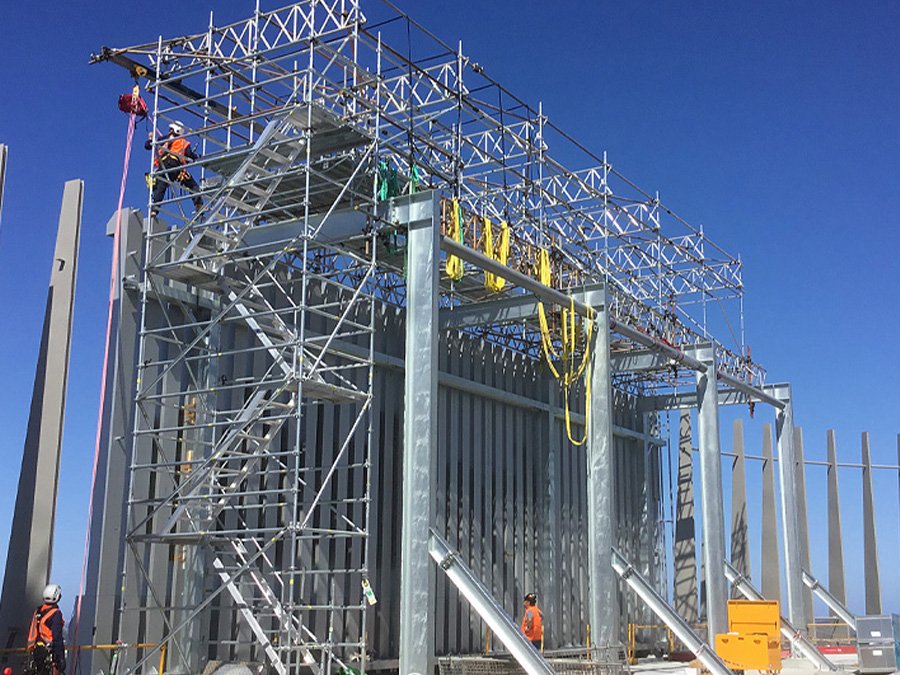Uncovering the Benefits of Scaffolding for Service Providers and Building And Construction Workers
The application of scaffolding in building tasks offers as a vital aspect for boosting operational efficiency and security. The complete scope of scaffolding's benefits extends past plain performance and safety and security-- there are deeper ramifications that call for additional exploration.

Enhanced Employee Safety And Security
Improved worker safety is a critical issue in the building and construction market, particularly when it pertains to using scaffolding. Correctly made and mounted scaffolding systems give crucial assistance for employees operating at elevations, significantly lowering the threat of drops, which are among the leading root causes of casualties in building and construction.
Scaffolding improves safety via its architectural honesty and layout functions that permit secure job platforms. High-quality scaffolding materials, such as steel or aluminum, deal sturdiness and strength, making sure that they can endure the weight and activity of employees and products. Security actions such as guardrails, toe boards, and access ladders are essential elements that protect against injuries and crashes.
Routine inspections and maintenance of scaffolding are crucial to support safety and security standards. Building and construction managers should ensure that employees are adequately trained in scaffold use and safety procedures, stressing the value of adhering to established standards. This extensive strategy not only secures employees yet also cultivates a culture of safety and security within the company. Therefore, purchasing correct scaffolding solutions is not simply a regulative need; it is a basic aspect of advertising a safe functioning setting in the construction industry.
Enhanced Availability
Availability in the building industry is important for promoting efficiency and productivity on work websites. Scaffolding offers a versatile solution that significantly enhances access for service providers and building and construction employees. By supplying secure systems at various heights, scaffolding makes it possible for workers to reach elevated areas securely and properly, lowering the requirement for cumbersome ladders or unpleasant placements that can prevent development.
The layout of scaffolding systems enables for easy activity of personnel, products, and tools, simplifying process and minimizing hold-ups. With proper scaffolding in area, employees can work together much more properly, as multiple staff member can operate simultaneously in a constrained area without endangering safety or access. This adaptability is particularly beneficial in complicated building and construction projects that need constant changes in height or placement.
Furthermore, scaffolding can be personalized to fit details job needs, making sure that all areas come regardless of the building's design. By boosting accessibility, scaffolding not just enhances the workplace however additionally adds to a more orderly website, therefore promoting a culture of efficiency and safety. In summary, improved access via scaffolding is a vital aspect in maximizing the efficiency of construction teams.
Enhanced Effectiveness
The application of scaffolding not only enhances availability yet additionally plays a significant role in increasing efficiency on construction sites. By offering a secure and stable system, scaffolding permits employees to execute jobs at height with greater ease and safety and security. This lowers the time invested moving products and tools, as everything required is within arm's reach. Subsequently, employees can focus on their certain jobs without regular interruptions.
Moreover, scaffolding allows multiple professions to function concurrently, improving collaboration and quickening job timelines. While one staff is installing visit homepage electric systems, one more can function on plumbing or completing jobs on the same degree, reducing downtime. The tactical design of scaffolding additionally assists in quicker activity across the website, eliminating the demand for constant elevation modifications or too much ladder use.

Cost-Effectiveness
While numerous may at first regard scaffolding as an extra expenditure, its application in fact contributes to substantial cost-effectiveness on construction tasks. By helping with more secure and much more reliable workplace, scaffolding decreases the risks of crashes and injuries, which can lead to expensive hold-ups and increased insurance coverage premiums.
Moreover, scaffolding improves efficiency by giving workers with instant accessibility to numerous degrees of a structure. This availability not just accelerates the pace of building yet also decreases labor prices, as employees can complete tasks a lot more quickly without the demand for cumbersome ladders or lifts.
Additionally, the modular nature of scaffolding enables for adaptability in its usage across numerous tasks, leading to reduced rental prices when compared to less adaptable alternatives. The ability to reuse scaffolding for different jobs further magnifies its cost-effectiveness, making certain a greater return on investment.
Versatility in Applications
Frequently recognized for its adaptability, scaffolding offers a variety of applications in the construction industry. Its versatility allows for usage in numerous tasks, from residential buildings to large-scale business developments. Scaffolding systems can be customized to fit various website problems, suiting special building designs and heights.
Along with typical building and construction, scaffolding is additionally vital for maintenance and repair service tasks. Whether it includes painting, home window installment, or facade remediation, scaffolding supplies a stable platform that improves employee security and efficiency. Its modular layout enables quick setting up and disassembly, making it suitable for jobs with tight timelines.
Furthermore, scaffolding is not limited to vertical frameworks; it can be effectively made use visit this site right here of in bridge building and construction, industrial centers, and even temporary occasion spaces. The ability to adjust scaffolding for different settings makes sure that specialists can meet diverse project needs without jeopardizing safety and security or availability.
This multifunctionality underscores the relevance of scaffolding in modern building and construction practices, making it possible for professionals and building and construction workers to perform their tasks with higher adaptability and precision. Eventually, the versatility of scaffolding contributes significantly to the general success of building and construction projects across different industries.

Conclusion
In summary, the advantages of scaffolding for contractors and building workers are considerable. Enhanced worker safety decreases loss threats, while boosted accessibility ensures that raised locations can be reached with ease. Increased efficiency is attained click here for more info with seamless workflows, and cost-effectiveness is realized by maximizing source allotment. Additionally, the versatility in applications permits scaffolding to adapt to numerous task demands. Collectively, these advantages add to a safer, extra effective, and economically viable building and construction setting.
The execution of scaffolding in construction tasks serves as a crucial component for improving operational efficiency and safety. Scaffolding gives a flexible remedy that substantially enhances availability for professionals and building and construction employees. In recap, boosted access through scaffolding is an essential element in maximizing the performance of building and construction teams.
The application of scaffolding not just improves availability yet also plays a considerable role in enhancing effectiveness on construction websites. Temporary Roof Scaffolding.In summary, the advantages of scaffolding for specialists and construction workers are considerable